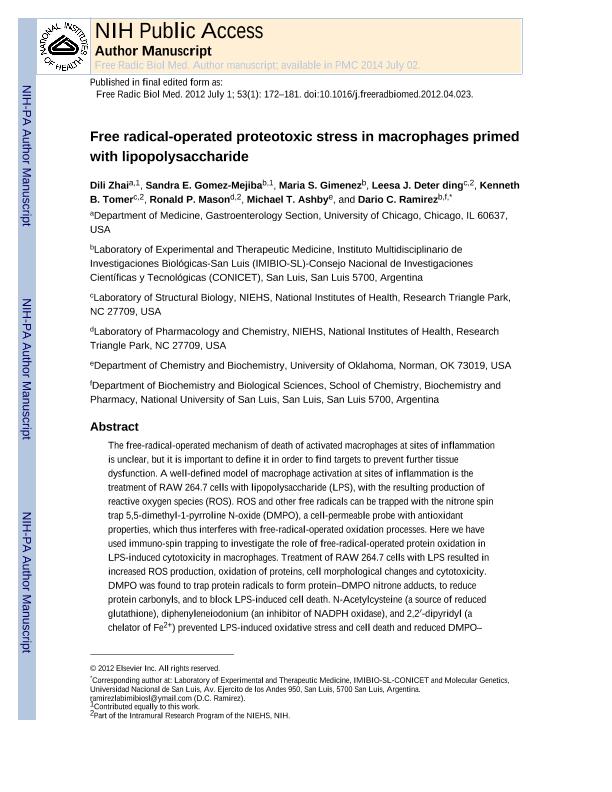Artículo
Free radical-operated proteotoxic stress in macrophages primed with lipopolysaccharide
Zhai, Zili; Gomez-Mejiba, Sandra Esther ; Gimenez, Maria Sofia
; Gimenez, Maria Sofia ; Deterding, Leesa J.; Tomer, Kenneth B.; Mason, Ronald P.; Ramirez, Dario
; Deterding, Leesa J.; Tomer, Kenneth B.; Mason, Ronald P.; Ramirez, Dario ; Ramirez, Dario
; Ramirez, Dario
 ; Gimenez, Maria Sofia
; Gimenez, Maria Sofia ; Deterding, Leesa J.; Tomer, Kenneth B.; Mason, Ronald P.; Ramirez, Dario
; Deterding, Leesa J.; Tomer, Kenneth B.; Mason, Ronald P.; Ramirez, Dario ; Ramirez, Dario
; Ramirez, Dario
Fecha de publicación:
07/2012
Editorial:
Elsevier Science Inc.
Revista:
Free Radical Biology and Medicine
ISSN:
0891-5849
Idioma:
Inglés
Tipo de recurso:
Artículo publicado
Clasificación temática:
Resumen
The free-radical-operated mechanism of death of activated macrophages at sites of inflammation is unclear, but it is important to define it in order to find targets to prevent further tissue dysfunction. A well-defined model of macrophage activation at sites of inflammation is the treatment of RAW 264.7 cells with lipopolysaccharide (LPS), with the resulting production of reactive oxygen species (ROS). ROS and other free radicals can be trapped with the nitrone spin trap 5,5-dimethyl-1-pyrroline N-oxide (DMPO), a cell-permeable probe with antioxidant properties, which thus interferes with free-radical-operated oxidation processes. Here we have used immuno-spin trapping to investigate the role of free-radical-operated protein oxidation in LPS-induced cytotoxicity in macrophages. Treatment of RAW 264.7 cells with LPS resulted in increased ROS production, oxidation of proteins, cell morphological changes and cytotoxicity. DMPO was found to trap protein radicals to form protein-DMPO nitrone adducts, to reduce protein carbonyls, and to block LPS-induced cell death. N-Acetylcysteine (a source of reduced glutathione), diphenyleneiodonium (an inhibitor of NADPH oxidase), and 2,2´-dipyridyl (a chelator of Fe(2+)) prevented LPS-induced oxidative stress and cell death and reduced DMPO-nitrone adduct formation, suggesting a critical role of ROS, metals, and protein-radical formation in LPS-induced cell cytotoxicity. We also determined the subcellular localization of protein-DMPO nitrone adducts and identified some candidate proteins for DMPO attachment by LC-MS/MS. The LC-MS/MS data are consistent with glyceraldehyde-3-phosphate dehydrogenase, one of the most abundant, sensitive, and ubiquitous proteins in the cell, becoming labeled with DMPO when the cell is primed with LPS. This information will help find strategies to treat inflammation-associated tissue dysfunction by focusing on preventing free radical-operated proteotoxic stress and death of macrophages.
Archivos asociados
Licencia
Identificadores
Colecciones
Articulos(IMIBIO-SL)
Articulos de INST. MULTIDICIPLINARIO DE INV. BIO. DE SAN LUIS
Articulos de INST. MULTIDICIPLINARIO DE INV. BIO. DE SAN LUIS
Citación
Zhai, Zili; Gomez-Mejiba, Sandra Esther; Gimenez, Maria Sofia; Deterding, Leesa J.; Tomer, Kenneth B.; et al.; Free radical-operated proteotoxic stress in macrophages primed with lipopolysaccharide; Elsevier Science Inc.; Free Radical Biology and Medicine; 53; 1; 7-2012; 172-181
Compartir
Altmétricas



